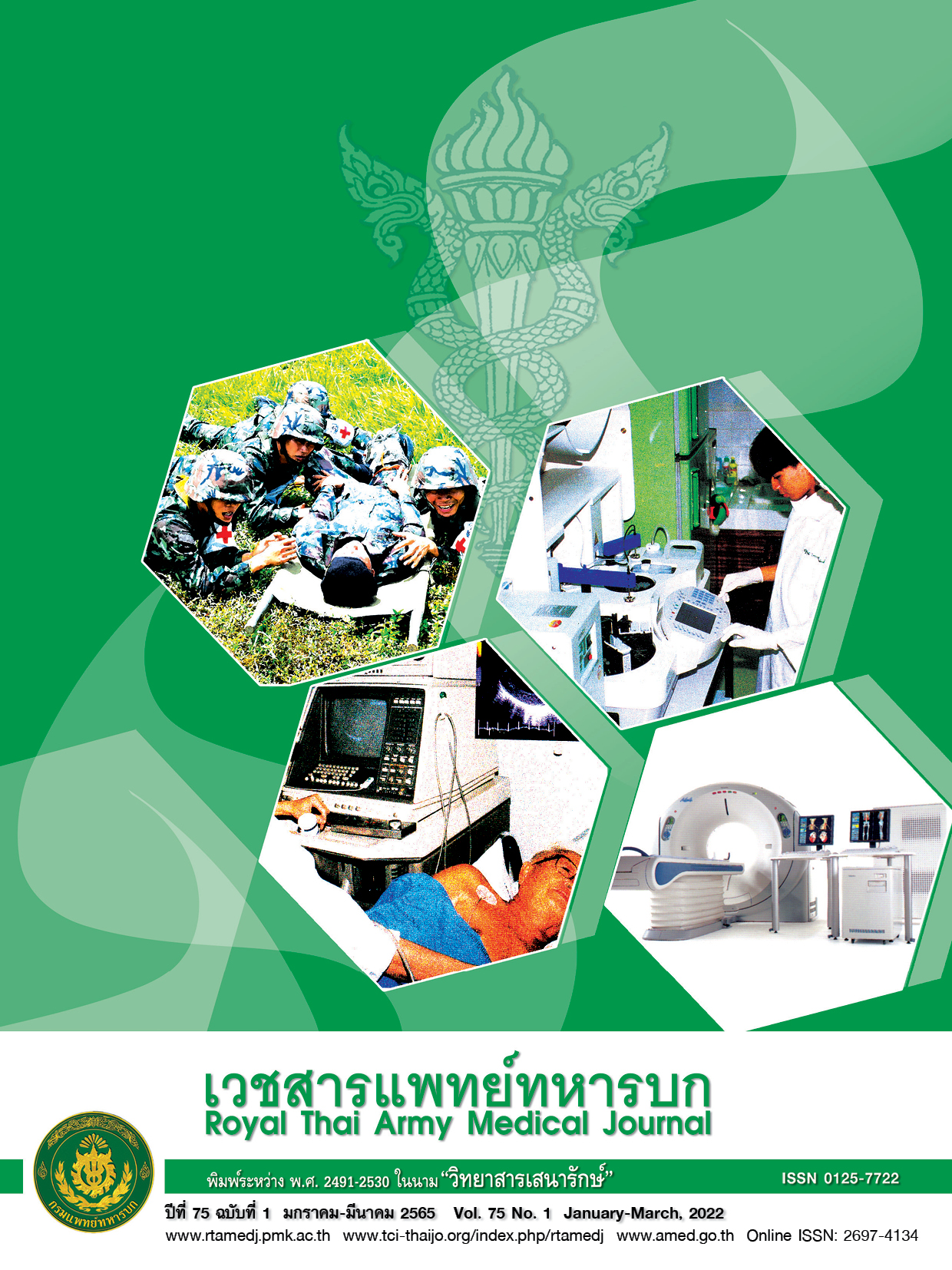Factors affecting to survival of overweight and obesity among the health check-up examinees at the Division of Preventive Medicine, Directorate of Medical Services, RTAF
Main Article Content
Abstract
ความเป็นมา ปัจจุบันภาวะน้ำหนักเกินและโรคอ้วนเป็นปัญหาสุขภาพที่สำคัญในกำลังพลภาคพื้น กองทัพอากาศที่นำไปสู่โรคไร้เชื้อเรื้อรัง วัตถุประสงค์ เพื่อคำนวณระยะปลอดเหตุการณ์และค้นหาปัจจัยที่มีความสัมพันธ์กับภาวะน้ำหนักเกินและโรคอ้วน ในกำลังพลภาคพื้น กองทัพอากาศ ณ ที่ตั้งดอนเมือง วิธีการศึกษา Retrospective cohort study โดยคัดเลือกกำลังพลฯ ที่มีค่าดัชนีมวลกายปกติในการตรวจสุขภาพครั้งแรกจากฐานข้อมูลตรวจสุขภาพประจำปี ณ กองเวชศาสตร์ป้องกัน ระหว่าง เดือนมีนาคม 2552-ธันวาคม 2557 และติดตามภาวะน้ำหนักเกินและโรคอ้วนทุกปี จนถึงวันที่ 30 ธันวาคม 2562 วิเคราะห์ข้อมูลด้วยสถิติเชิงพรรณา ค่ามัยธฐานระยะปลอดเหตุการณ์ด้วยโค้งปลอดเหตุการณ์ Kaplan-Meier เปรียบเทียบด้วย log-rank test และระบุปัจจัยที่มีความสัมพันธ์ด้วย Cox proportional hazard model ผลการศึกษา กำลังพลฯที่เข้ารับการตรวจสุขภาพจำนวน 5,312 คน มีระยะเวลาในการติดตามระหว่าง 5-10 ปี ค่ามัธยฐานระยะปลอดเหตุการณ์ของภาวะน้ำหนักเกินและโรคอ้วน เท่ากับ 8 ปี อัตราการปลอดเหตุการณ์ ณ เวลา 5 ปี ร้อยละ 59.65 ผลการวิเคราะห์ด้วยแบบจำลอง Cox proportional hazard พบปัจจัยเสี่ยงของภาวะน้ำหนักเกินและโรคอ้วน ได้แก่ เพศชายมีความเสี่ยง 1.79 เท่า (95%CI: 1.60-1.99) กลุ่มอายุ < 26 ปี และ 26-35 ปี มีความเสี่ยงสูงกว่ากลุ่มอายุ > 45 ปี 1.58 เท่า (95%CI: 1.41-1.78) และ1.52 เท่า (95%CI:1.35-1.71) ตามลำดับ และคนสูบบุหรี่มีความเสี่ยงต่ำกว่าคนไม่สูบบุหรี่ 0.82 เท่า (95%CI: 0.74-0.91) เมื่อจำแนกตามหน่วยงาน ส่วนกิจการพิเศษมีความเสี่ยงตามกลุ่มอายุสูงกว่าหน่วยงานอื่นเกือบหนึ่งเท่าตัว โดยกลุ่มอายุ < 26 ปี และ 26-35 ปี มีความเสี่ยงสูงกว่ากลุ่มอายุ > 45 ปี 2.66 เท่า (95%CI: 1.72-4.11) และ 2.50 เท่า (95%CI: 1.63-3.84) ตามลำดับ สรุปผล กำลังพลฯชายและอายุน้อยกว่า 26 ปี มีความเสี่ยงต่อภาวะน้ำหนักเกินและโรคอ้วนสูง จึงควรให้ความสำคัญกับการส่งเสริมสุขภาพ เพื่อลดความเสี่ยงต่อการเกิดโรคไร้เชื้อเรื้อรังในอนาคต
Downloads
Article Details

This work is licensed under a Creative Commons Attribution-NonCommercial-NoDerivatives 4.0 International License.
Articles in this journal are copyrighted by the Royal Thai Army Medical Department and published under the Creative Commons Attribution-NonCommercial-NoDerivatives 4.0 International (CC BY-NC-ND 4.0) license.
may be read and used for academic purposes, such as teaching, research, or citation, with proper credit given to the author and the journal.
Use or modification of the articles is prohibited without permission.
Statements expressed in the articles are solely the opinions of the authors.
Authors are fully responsible for the content and accuracy of their articles.
Any other republication of the articles requires permission from the journal.
References
2. Wichai Aekplakorn e. Thai National Health Examination Survey, NHES V (2014). Nonthaburi HSRI; 2016.
3. Pitayatienanan P, Butchon R, Yothasamut J, Aekplakorn W, Teerawattananon Y, Suksomboon N, et al. Economic costs of obesity in Thailand: a retrospective cost-of-illness study. BMC Health Serv Res. 2014;14:146.
4. Burden of Disease Research Program Thailand. Thailand burden of diseases attributable to risk factors 2014. Nonthaburi 2018.
5. Hatthachote P, Rangsin R, Mungthin M, Sakboonyarat B. Trends in the prevalence of obesity among young Thai men and associated factors: from 2009 to 2016. Mil Med Res. 2019;6(1):13.
6. Mazokopakis EE, Papadakis JA, Papadomanolaki MG, Vrentzos GE, Ganotakis ES, Lionis CD. Overweight and obesity in Greek warship personnel: prevalence and correlations. Eur J Public Health. 2004;14(4):395-7.
7. Reyes-Guzman CM, Bray RM, Forman-Hoffman VL, Williams J. Overweight and Obesity Trends Among Active Duty Military Personnel: A 13-Year Perspective. Am J Prev med. 2015;48(2):145-53.
8. Lee JH, Seo DH, Nam MJ, Lee GH, Yang DH, Lee MJ, et al. The Prevalence of Obesity and Metabolic Syndrome in the Korean Military Compared with the General Population. J Korean Med Sci. 2018;33(25).
9. Horaib G, Al-Khashan H, Mishriky A, Selim M, Alnowaiser N, Binsaeed A, et al. Prevalence of obesity among military personnel in Saudi Arabia and associated risk factors. Saudi Med J. 2013;34:401-7.
10. Smith TJ, Marriott BP, Dotson L, Bathalon GP, Funderburk L, White A, et al. Overweight and obesity in military personnel: sociodemographic predictors. Obesity (Silver Spring, Md). 2012;20(7):1534-8.
11. The Royal Decree on the Classification of Government Agencies and the Assignment of Duty for the Royal Thai Air Forces Headquarters,the Royal Thai Air Forces, Ministry of Defence B.E. 2552. Royal Thai Government Gazette Vol. 126, Issue 19 (March 30,2552). p. 36-45.
12. Napradit P, Pantaewan P, Nimit-arnun N, Souvannakitti D, Rangsin R. Prevalence of overweight and obesity in Royal Thai Army personnel. J Med Assoc Thai. 2007;90(2):335-40.
13. Division of Preventive Medicine, Directorate of Medical Services, RTAF. Annual check-up examinees of Royal Thai Air Force ground personnel. 2018.
14. Lindquist CH, Bray RM. Trends in overweight and physical activity among U.S. military personnel, 1995-1998. Prev Med.2001;32(1):57-65.
15. Lang TF. The bone-muscle relationship in men and women. J Osteoporos. 2011;2011:702735.
16. Sedek R. Body mass ibdex and body composition among royal malasia navy personnel (RMN) personnel. J of defence and security. 2010;1:2010.
17. Sundin J, Fear NT, Wessely S, Rona RJ. Obesity in the UK Armed Forces: risk factors. Mil Med. 2011;176(5):507-12.
18. Mazokopakis EE, Papadakis JA, Papadomanolaki MG, Vrentzos GE, Ganotakis ES, Lionis CD. Overweight and obesity in Greek warship personnel: Prevalence and correlations. Eur J Public Health. 2004;14(4):395-7.
19. Mullie P, Vansant G, Guelinckx I, Hulens M, Clarys P, Degrave E. Trends in the evolution of BMI in Belgian army men. Public Health Nutr. 2009;12(7):917-21.
20. Kerrigan DJ, Rukstalis MR, Ehrman JK, Keteyian SJ, She R, Alexander GL. 5-2-1-0 Lifestyle risk factors predict obesity in Millennials. Clin Obes. 2019 Jun;9(3):e12306
21. Audrain-McGovern J, Benowitz NL. Cigarette smoking, nicotine, and body weight. Clin Pharmacol Ther. 2011;90(1):164-8.
22. Filho RT, D'Oliveira A Jr. The Prevalence of Metabolic Syndrome Among Soldiers of the Military Police of Bahia State, Brazil. Am J Mens Health. 2014 Jul;8(4):310-5
23. Kijjaruck W. Guidelines for the development of personnel and armament capabilities of the Office of Donmuang RTAF Base Commander.To cope with new threats and challenges. [Internet] [cited 2021 Jun]. Available from: http://www.dsdw2016.dsdw.go.th/doc_pr/ndc_2559-2560/PDF/wpa_8232/ALL.pdf.
24. Bremner JD, Moazzami K, Wittbrodt MT, Nye JA, Lima BB, Gillespie CF, et al. Diet, Stress and Mental Health. Nutrients. 2020;12(8).
25. Da Silva FC, Hernandez SSS, Arancibia BAV, Castro TLdS, Filho PJBG, da Silva R. Health-related quality of life and related factors of military police officers. Health Qual Life Outcomes. 2014;12(1):60.


